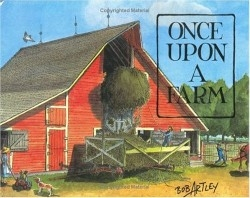It looks like you've stumbled upon a page meant to be read by our code instead of viewed directly. You're probably looking for this page.
Once Upon a Farm
Author and illustrator Artley provides a look back at agricultural life in the early-twentieth century by recalling life on the Iowa farm where he grew up. Without any preaching or over-romanticizing, his book also is a reminder of what is being lost in America’s culture as corporate agriculture displaces family farms, rural communities, and people’s connection to how their food is grown.
Artley’s parents started their 200-acre farm in April 1917, shortly before he was born. His book charts a year there through the seasons.
The book includes a collection of his illustrations, watercolors, and line drawings that appeared in the Worthington (Minnesota) Daily Globe and other publications and books, including the book Country Christmas, As Remembered by a Former Kid. Often, Artley’s illustrations have a homespun feel reminiscent of Norman Rockwell. His writing is conversational and informative, like one neighbor talking to another, or a grandfather sharing history and lost practical skills with his grandchildren. It seems appropriate not only for adults but for reading together with children.
Artley evokes the senses of a life spent outdoors; long marked by the sounds and smells of nature rather than industry. He describes a “cocoon of silence” for the farmer moving across the field with a team of horses. When his father bought a tractor, he could plow longer days than a horse’s stamina made possible, but there was a deafening roar drowning out birdsong and “the exhaust fumes and the smell of the hot grease of the engine smothered the sweet odor of the crushed grasses and the moist, rich soil.”
One of the pleasures of physical work was that it was often communal. He cranked a wringer washer with his mother and learned her world of books and ideas in the process. Neighbors went in together to rent a threshing machine to separate oat grain from straw, and then helped each other with the job.
Old farm implements become understandable, practical tools with Artley’s drawings and explanations. He also explains how farmers were their own plant geneticists, saving seed for next year’s crop, and how they provided most of their own food, from meat to milk and butter.
As nature writer and lecturer Paul Gruchow says in the Foreword: “The odd notion has taken hold that because farm life early in this century was laborious, it was also mean and hard, an endless drudgery, a hellish burden to those who knew it. Partly this notion reflects the post-industrial doctrine that physical labor is inherently repulsive…What is at stake here is the usefulness of the past.”
Reviewed by
Diane Conners
Disclosure: This article is not an endorsement, but a review. The publisher of this book provided free copies of the book to have their book reviewed by a professional reviewer. No fee was paid by the publisher for this review. Foreword Reviews only recommends books that we love. Foreword Magazine, Inc. is disclosing this in accordance with the Federal Trade Commission’s 16 CFR, Part 255.
